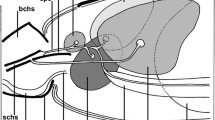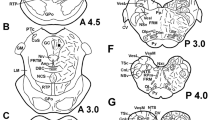Summary
The suitability of several radioactive precursors for studying the secretory processes in the cells of the subcommissural organ (SCO) of frogs (Rana temporaria) was tested by means of autoradiography. Special attention was paid to: (a) the contributions made by different cellular compartments to the glycosilation of the secretory product, and (b) the intracellular turnover rate of the secretory material. From the results it is concluded that: (1)3H-glucosamine excellently labels Reissner's fibre (RF) in autoradiographs, much better than any other of the radioactive precursors applied. (2)3H-glucosamine molecules are attached to the protein moiety of the secretory product within the periand subnuclear granular endoplasmic reticulum, whereas3H-fucose and additional3H-glucosamine molecules are added to the oligosaccharide moiety in the supranuclear Golgi apparatus, previous to apical release; consequently, the subnuclear secretory material and the material that is released into the brain ventricle are chemically different so far as the oligosaccharide moiety is concerned. (3) The oligosaccharide portion of the apical secretory product belongs (at least partially) to the class of the N-linked complex type oligosaccharides. (4) The intracellular half-life of the subnuclear secretory material is at least 5.5 days. (5) The subnuclear secretory material in the ependymal SCOcells presumably has to pass through the Golgi apparatus before it can be released; this release probably occurs at the apical cell border.
Similar content being viewed by others
References
Alberts B, Bray D, Lewis J, Raff M, Roberts K, Watson JD (1983) Molecular Biology of the Cell. Garland Publishing Inc., New York and London, pp 319–384
Bennett G, Leblond CP (1977) Biosynthesis of the glycoproteins present in plasma membrane, lysosomes and secretory materials, as visualized by radioautography. Histochem J 9:393–417
Bennett G, O'Shaughnessy D (1981a) The site of incorporation of sialic acid residues into glycoproteins and the subsequent fates of these molecules in various rat and mouse cell types as shown by radioautography after injection of (3H)-N-acetylmannosamine. I. Observations in hepatocytes. J Cell Biol 88:1–15
Bennett G, Kan FWK, O'Shaughnessy D (1981b) The site of incorporation of sialic acid residues into glycoproteins and the subsequent fates of these molecules in various rat and mouse cell types as shown by radioautography after injection of (3H)-N-acetylmannosamine. II. Observations in tissues other than liver. J Cell Biol 88:16–28
Dautry-Varsat A, Lodish HF (1983) The Golgi complex and the sorting of membrane and secreted proteins. Trends in Neuro-sciences 6:484–490
Diederen JHB (1970) The subcommissural organ ofRana temporaria L. A cytological, cytochemical, cyto-enzymological and electron microscopical study. Z Zellforsch 111:379–403
Diederen JHB (1972) Influence of light and darkness on the subcommissural organ ofRana temporaria L. A cytological and autoradiographical study. Z Zellforsch 129:237–255
Diederen JHB (1973) Influence of light and darkness on secretory activity of the subcommissural organ and on growth rate of Reissner's fibre inRana esculenta L. A cytological and autoradiographical study. Z Zellforsch 139:83–94
Diederen JHB (1975) A possible functional relationship between the subcommissural organ and the pineal complex and lateral eyes inRana esculenta andRana temporaria. Cell Tissue Res 158:37–60
Diederen JHB, Vullings HGB (1980) Comparison of several parameters related to the secretory activity of the subcommissural organ in European green frogs. Cell Tissue Res 212:383–394
Droz B, Warshawsky H (1962) Reliability of the radioautographic technique for the detection of newly synthesized protein. J Histochem Cytochem 11:426–435
Ermisch A, Sterba G, Mueller A, Hess J (1971) Autoradiographische Untersuchungen am Subcommissuralorgan und dem Reissnerschen Faden. I. Organsekretion und Parameter der Organleistung als Grundlagen zur Beurteilung der Organfunktion. Acta Zool 52:1–21
Gabe M (1968) Techniques histologiques. Masson et Cie, Paris, pp 362–366
Hädge D, Sterba G (1973a) Analytische Untersuchungen am Liquorfaden vom Rind. 1. Die Proteinkomponente. Acta Biol Med Germ 30:581–585
Hädge D, Sterba G (1973b) Analytische Untersuchungen am Liquorfaden vom Rind. 2. Die Kohlenhydratkomponentc. Acta Biol Med Germ 30:587–592
Kelly RB (1985) Pathways of protein secretion in eukaryotes. Science 230:25–32
Leonhardt H (1980) Ependym und Circumventriculäre Organe. In: Oksche A, Vollrath L (eds) Neuroglia I. Handbuch der mikroskopischen Anatomie des Menschen. Band IV, 10. Teil. Springer, Berlin Heidelberg New York, pp 472–504
Lösecke W, Naumann W, Sterba G (1984) Preparation and discharge of secretion in the subcommissural organ of the rat. An electronmicroscopic immunocytochemical study. Cell Tissue Res 235:201–206
Meiniel R, Meiniel A (1985) Analysis of the secretions of the subcommissural organs of several vertebrate species by use of fluorescent lectins. Cell Tissue Res 239:359–364
Ockenfels H, Pilgrim Ch, Unsöld M (1981) In-vitro-Studien zur fixierungsbedingten Artefaktbildung in der elektronenmikroskopischen Autoradiographie. Acta Histochem [Suppl] 24:301–307
Peters Th, Ashley Ch A (1967) An artefact in radioautography due to binding of free amino acids to tissues by fixatives. J Cell Biol 33:53–60
Pilgrim Ch, Saalmüller J, Reisert I (1982) Extraction of label during processing of brain tissue for electron microscopic autoradiographic investigation of glycoprotein metabolism. Histochemistry 74:271–278
Rodríguez EM, Herrera H, Peruzzo B, Rodríguez S, Hein S, Oksche A (1986) Light- and electron-microscopic immunocytochemistry and lectin histochemistry of the subcommissural organ: evidence for processing of the secretory material. Cell Tissue Res 243:545–559
Stanka P (1967) Über den Sekretionsvorgang im Subcommissuralorgan eines Knochenfisches (Pristella riddlei Meek.). Z Zellforsch 77:404–415
Sterba G, Müller H, Naumann W (1967) Fluoreszenzund elektronenmikroskopische Untersuchungen über die Bildung des Reissnerschen Fadens beiLampetra planeri (Bloch.) Z Zellforsch 76:355–376
Van Nieuw Amerongen A, Ferwerda W, Roukema PA (1974) Incorporation of D-(3H)-glucosamine into the sialoglycoprotein GP-350 of adult rat brain. J Neurochem 23:405–409
Vullings HOB, Diederen JHB, Smeets AJM (1983) Influences of light on the subcommissural organ in European green frogs. Comp Biochem Physiol 74A:455–458
Vullings HGB, Diederen JHB (1985) Secretory activity of the subcommissural organ inRana temporaria under osmotic stimulation. Cell Tissue Res 241:663–670
Author information
Authors and Affiliations
Additional information
Dedicated to Prof. Dr. J.C. van de Kamer on the occasion of his 70th birthday, to Prof. Dr. Dr. h.c. G. Sterba on the occasion of his 65th birthday, and to Prof. Dr. Drs. h.c. A. Oksche on the occasion of his 60th birthday
Rights and permissions
About this article
Cite this article
Diederen, J.H.B., Vullings, H.G.B. & Legerstee-Oostveen, G.G. Autoradiographic study of the production of secretory material by the subcommissural organ of frogs (Rana temporaria) after injection of several radioactive precursors, with special reference to the glycosilation and turnover rate of the secretory material. Cell Tissue Res. 248, 215–222 (1987). https://doi.org/10.1007/BF01239983
Accepted:
Issue Date:
DOI: https://doi.org/10.1007/BF01239983




